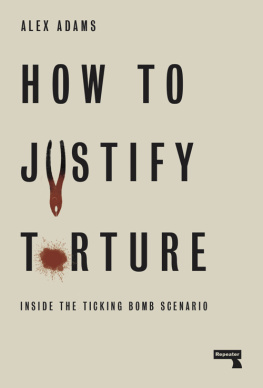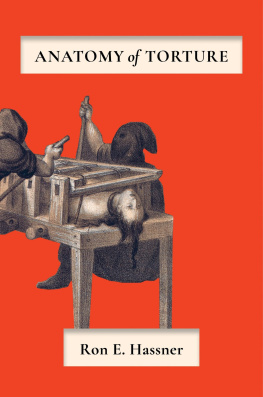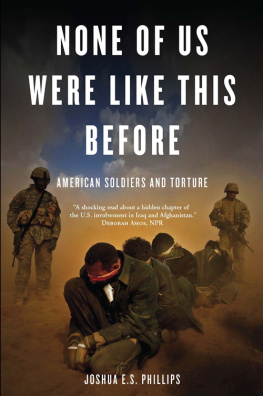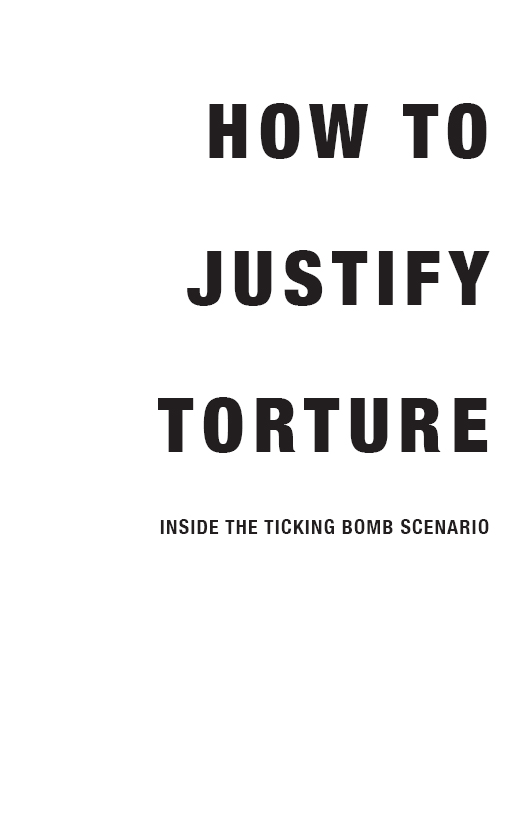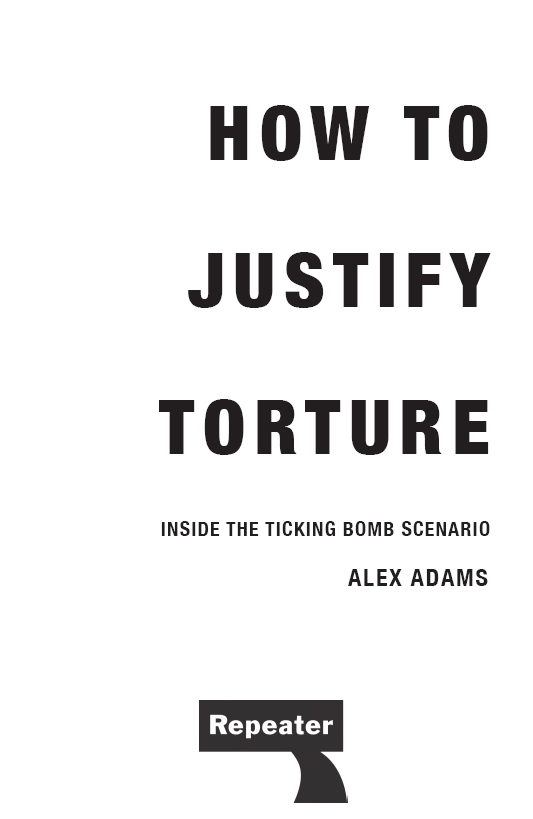CONTENTS
DEDICATION
In Memory of
Elisa Nauman (19852009)
Bob Adams (19522012)
For Hannah Burman and RM
INTRODUCTION
TORTURE AND THE TEXTURE OF COMMON SENSE
Its impossible to debate the obvious.
Alexis Jenni
Hold on. The ticking what scenario? What bomb?
The ticking bomb scenario is a thought experiment about when, if ever, it is morally right to commit torture. If youve ever had a conversation about torture, youve almost certainly heard it. It is most often framed as a rhetorical question, demanding a personalized response, which steers respondents towards a particular answer. The argument usually runs along the following lines. Everybody knows that torture, under normal conditions, cannot be justified, because it is a disgusting, extreme and grotesque form of mistreatment, practiced only by deranged psychopaths or sordid government thugs, which results in extreme pain and distress, possibly even death, for the victim. Nobody, of course, is trying to justify torture per se. But imagine, if you can, that a timebomb was hidden in a city, the timer mercilessly ticking towards detonation, and you had the criminal responsible for it in your custody. This is different: its not a lone psycho horribly torturing someone for their own amusement, or a state brownshirt murdering political dissidents in the torture basements of some totalitarian regime. Would you would you torture this incontrovertibly guilty terrorist in order to acquire the vital information about the location of the bomb that could, at the last minute, prevent it from exploding and claiming hundreds or thousands of innocent victims?
Perhaps, as in Gregor Jordans movie Unthinkable, a terrorist has planted nuclear bombs in three cities across the USA and has made grandiose geopolitical demands he knows cannot be satisfied. Perhaps, as in Jean Lartguys novel The Centurions, a group of nationalist guerillas has placed fifteen timebombs in a colonial capital city as part of their armed campaign of anticolonial violence. Or perhaps, as in the Charles Bronson vehicle Death Wish V: The Face of Death, a desperate man needs to rescue his kidnapped stepdaughter in order to protect her from being murdered by a creepy, emotionless gangster. Is torture, in these scenarios, the right answer, the right thing to do?
The ticking bomb scenario comes in many forms. It is framed in a range of ways, dramatized in an enormous variety of genres, and invokes a wide selection of overlapping ideas, but its essential components are nearly always the same the urgent, time-limited emergency, the guilty captive, and the assumption that perpetrating torture upon this captive will produce definite, specific information that will lead directly to the satisfactory resolution of the emergency and the rescue of innocent victims. It is, therefore, implied in the structure of the question itself that it only admits one morally acceptable response: yes, if we assume that torture will work, if it is given that torture is in this situation the lesser of two evils, and if it has the potential to protect innocent life, then yes, torture can be condoned.
Examples can be found in philosophy and political writing as often as they can be found in fiction. Some day soon a terrorist will threaten tens of thousands of lives, and torture will be the only way to save them, wrote philosopher Michael Levin in 1982, for instance. His short article, peppered with emotive hypothetical situations such as the detonation of a nuclear weapon in New York City on the fourth of July, argued emphatically that torture under ticking bomb conditions is not merely permissible but morally mandatory. It is obvious, for Levin, that when confronted with the opportunity to prevent apocalyptic destruction through the act of physical torture against the individual responsible for it, one should have absolutely no scruples about doing so.
Twenty years later, Alan Dershowitz, the civil rights attorney and novelist who has made a lucrative and high-profile career defending provocative positions, argued that the US and other torturing democracies should issue what he described as torture warrants in the case of ticking bomb emergencies. He argues firstly that it is surely better to inflict nonlethal pain on one guilty terrorist who is illegally withholding information needed to prevent an act of terrorism than to permit a large number of innocent victims to die, and posits secondly that torture would certainly be committed were such an event to materialize. In other words, everyone would agree that torture against one person is better than a terrorist attack against many people, because it involves fewer people experiencing less pain; he then assumes that the police or military forces responsible for the emergency would share this view and would decide to commit torture in order to prevent such an attack. From here he proceeds to the conclusion that ticking bomb torture should be sanctioned by law in a limited category of exceptional circumstances, in order to legally protect the agents of law and order, who are, according to Dershowitz, only doing the obvious and natural thing, the thing that any one of us would do in such a situation.
Thirteen years later, Donald Trump repeatedly defended torture in the course of his election campaign. In Republican debates he won support for his presidential candidacy by claiming that he would bring back waterboarding and a hell of a lot worse.
Given that the President of the USA vocally defends torture at any given opportunity, and that he has appointed Gina Haspel, whose career as a CIA field agent involved running a black site torture prison, to the directorship of the CIA, Given the international resurgence of torture as a global issue, it seems appropriate for opponents of torture to subject the justifications for torture that circulate in popular cultural and political discourse to critical scrutiny. That is the task of this short book.
DEFENDING TORTURE
It might be framed as a question, but the conclusion that framers of the ticking bomb scenario want respondents to reach is never really open or in doubt. It is designed, like other rhetorical thought experiments, to guide us to a predetermined conclusion. In this case, we are supposed to admit that, although torture is normally wrong, and should never be done as a matter of routine, the ticking bomb emergency provides us with a special exception, a one-of-a-kind situation in which torture might actually be good, might actually help. As a consequence of admitting that such a situation is plausible, however, we can no longer sustain the idea that torture is always wrong. This is an admission with enormous political consequences. By positing an extreme limit case in which torture appears morally defensible, it seeks to puncture the absolute prohibitions that surround torture in mainstream ethical and moral thinking and in national and international law. That is, the ticking bomb scenario is an argument that defends and endorses torture, and which does its work by deliberately undermining one of the most important political and ethical principles in the world. Once we admit that torture is not always wrong because it could save innocent lives, we grant moral legitimacy, even heroic status, to torturers.
This would not be a problem if the ticking bomb scenario was not so persuasive. But, unfortunately, it is a very attractive argument for many people. Film reviewer Mark Lambert writes that the torture scene in

